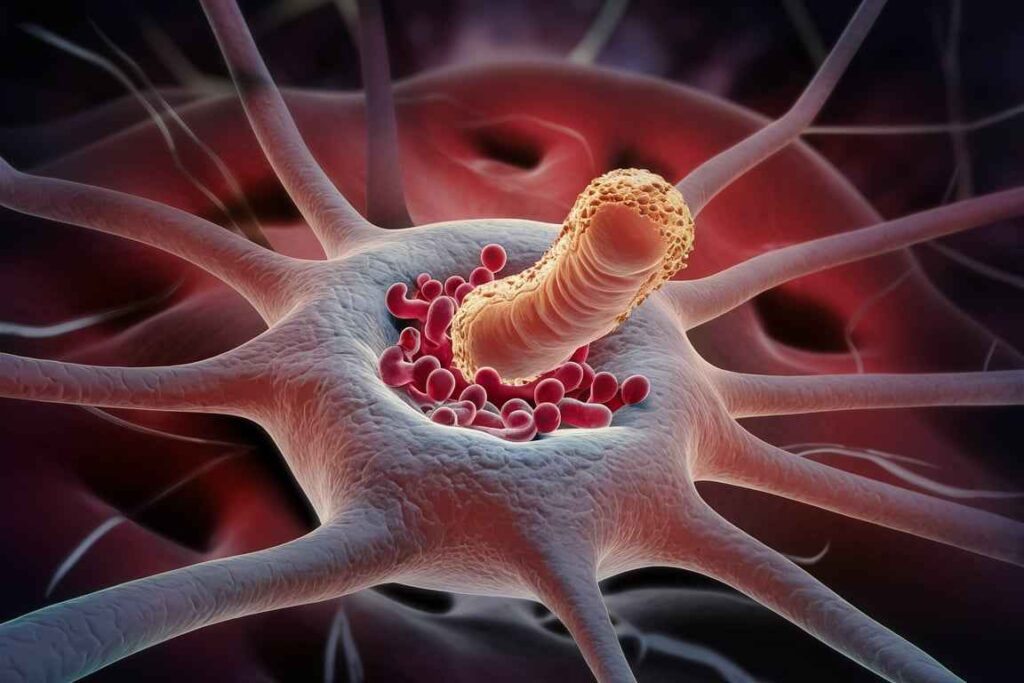Mycobacterium leprae is a unique pathogen adapted to intracellular survival within human hosts, causing the chronic infectious disease leprosy. Its complex cell wall structure, ability to evade immune responses, and neuropathogenicity contribute to the diverse clinical manifestations observed in affected individuals. Understanding the molecular and pathophysiological mechanisms of M. leprae infection is crucial for developing effective diagnostic methods, treatments, and public health strategies aimed at controlling and ultimately eliminating leprosy globally.
Table of Contents
Mycobacterium leprae
The bacterium that causes leprosy, commonly referred to as Hansen’s disease, is called Mycobacterium leprae. It is an intracellular, acid-fast pathogen that mostly affects human skin, peripheral nerves, and upper respiratory tract mucosa. This bacteria is resistant to environmental stressors and host immunological responses because of its special cell wall structure, which is rich in mycolic acids.

M. leprae is difficult to research and diagnose because of its extremely sluggish growth rate and inability to be grown on artificial laboratory media. It is mainly transmitted by extended close contact with untreated cases of the infectious form of leprosy. Tropical and subtropical climates are ideal for its growth, as they may facilitate transmission due to hygienic conditions and way of life. Understanding Mycobacterium leprae is crucial for developing effective diagnostic methods, treatments, and public health strategies aimed at controlling and eventually eliminating leprosy as a global health problem.
General Characteristics
Leprosy, commonly called Hansen’s disease, is a chronic infectious disease that mostly affects the skin, peripheral nerves, and upper respiratory tract mucosa. It is caused by the bacteria Mycobacterium leprae. It is an intracellular, acid-fast bacterium that is a member of the Mycobacterium genus, which also contains Mycobacterium TB, the tuberculosis-causing bacteria.
Morphology:
- M. leprae is rod-shaped and thin, usually measuring between two and six micrometers in length and 0.2 and 0.5 micrometers in width.
- Its distinctive waxy outer layer, which is made up of mycolic acids, is one of the things that makes it stain quickly with acids.
Growth Characteristics:
M. leprae grows very slowly and is challenging to produce in synthetic lab media. Its affinity for colder areas of the human body, such the skin and peripheral nerves, is consistent with its ideal growth temperature of approximately 37°C.
Genome:
At 3.27 million base pairs, M. librae’s genome is among the smallest of all known human disease-causing bacteria.
Its evolutionary history has been marked by substantial reduction, with many of the genes required for independent existence outside of the human host being lost.

Habitat

Natural Habitat:
The skin and peripheral nerves of infected persons are the primary habitats of M. leprae.
Additionally, it may have an impact on the mucosa of the upper respiratory tract, especially in lepromatous leprosy cases.
Transmission:
- Although the precise method of M. leprae transmission is not entirely understood, it is thought to happen through extended close contact with untreated cases of the infectious form of leprosy.
- Particularly in endemic locations, respiratory droplets from infected people may also contribute to transmission.
Geographical Distribution:
Leprosy is primarily found in tropical and subtropical areas, and it is highly endemic in a number of African, South American, and Indian nations.
Virulence Factors
Cell Wall Composition:
- M. leprae’s pathogenicity is greatly enhanced by its distinct cell wall structure.
- Its ability to survive inside host cells and fend off host immunological responses depends on the complex lipids it contains, such as mycolic acids.
Intracellular Survival:
- Being an obligate intracellular pathogen, M. leprae can only exist and multiply inside of its host cells, specifically macrophages and Schwann cells (which are responsible for producing the myelin sheath that surrounds peripheral nerves).
- Its chronic nature and the protracted course of leprosy are partly caused by its capacity to elude host immune responses and survive within these cells.
Antigenic Variation:
- Antigenic variation is exhibited by M. leprae, which modifies its surface antigens to avoid identification and clearance by the host immune system.
- This leads to a variety of leprosy clinical presentations, from lepromatous leprosy (multibacillary) to tuberculoid leprosy (paucibacillary).
Suppression of Host Immune Response:
- By preventing macrophages and other immune cells from activating, M. leprae tampers with the host immunological response.
- It releases chemicals that alter the production of cytokines by the host, favoring Th2-type immune responses, which are less successful in stopping the development of bacteria.
Neuropathogenicity
- Peripheral nerves are particularly vulnerable to M. leprae, which can result in demyelination and other nerve damage.
- The neurological side effects of leprosy, such as deformities, weakening in the muscles, and sensory loss, are partly caused by this neuropathogenicity.
Diagnosis and Treatment
Diagnosis:
- Leprosy diagnosis is made by clinical assessment, skin biopsy for histological analysis, and skin smear or nerve biopsy detection of acid-fast bacilli.
- M. leprae DNA can be accurately detected in clinical samples using molecular methods like PCR (Polymerase Chain Reaction).
Treatment:
- For the treatment of leprosy, a combination of antibiotics such as clofazimine, rifampicin, and dapsone is prescribed as multidrug therapy (MDT).
- The course and mix of antibiotics are determined by the leprosy’s clinical manifestation and categorization (paucibacillary or multibacillary).
Public Health Measures:
- Leprosy control initiatives include contact tracking and screening of close connections, early diagnosis and treatment, and health education to lessen stigma and discrimination related to the illness.
- Worldwide endeavors strive to eradicate leprosy as a public health issue, emphasizing the mitigation of transmission and provision of all-encompassing care to those afflicted..
Frequently Asked Question
What is Mycobacterium leprae ?
Mycobacterium leprae is a bacterium responsible for causing leprosy, also known as Hansen’s disease. It is an acid-fast, intracellular pathogen that primarily infects the skin, peripheral nerves, and mucosa of the upper respiratory tract in humans.
What does Mycobacterium leprae cause?
Mycobacterium leprae is the bacterium that causes leprosy, also known as Hansen’s disease. Leprosy primarily affects the skin, peripheral nerves, upper respiratory tract, and eyes. If left untreated, it can lead to severe disfigurement, nerve damage, and disabilities.
What are the three main symptoms of leprosy?
The three main symptoms of leprosy are:
1. Skin Lesions
2. Nerve Damage
3. Eye Problems
Related Article




